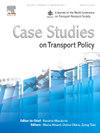Comparison of customer preferences in Malaysia and Indonesia to evaluate the need of charging infrastructure and dual battery electric motorcycle as an effort to increase the adoption rate of electric motorcycles
IF 2.4
Q3 TRANSPORTATION
引用次数: 0
Abstract
Global transportation energy consumption is projected to rise significantly from 2012 to 2040, with gasoline remaining the primary fuel source. Southeast Asia, particularly Indonesia and Malaysia, faces substantial air pollution challenges due to high motorcycle usage. Electric motorcycles (EMs) offer a potential solution; however, their adoption rates in these countries are currently low, falling short of government targets. Key obstacles include range anxiety and limited charging infrastructure, which hinder widespread EM adoption and demand substantial investment. This study aims to assess which approach: developing more charging stations or increasing the availability of dual battery EMs, would better address these barriers. Data from Malaysia was collected through a user survey and analyzed using the multinomial logit model, while data from Indonesia was gathered through a literature review of previous studies. The results reveal distinct consumer preferences in each country: Malaysian consumers prioritize EMs with advanced technological features and high battery range, while Indonesian consumers value cost-effective and practical EMs for short urban trips. Dual-battery EMs emerged as the preferred option in both markets, with a 51.3% probability of selection, slightly higher than the single-battery alternative (42.4%). These findings suggest that promoting dual-battery EMs could be more effective than expanding public charging infrastructure. Policymakers and industry stakeholders are advised to consider tailored strategies: focusing on affordability and dual-battery solutions in Indonesia and enhancing high-tech features in Malaysia. This approach aligns better with consumer demands in both countries, potentially accelerating EM adoption.
比较马来西亚和印度尼西亚的客户偏好,以评估充电基础设施和双电池电动摩托车的需求,以提高电动摩托车的采用率
从2012年到2040年,全球交通能源消耗预计将大幅上升,汽油仍是主要燃料来源。东南亚,特别是印度尼西亚和马来西亚,由于摩托车的大量使用,面临着严重的空气污染挑战。电动摩托车(em)提供了一个潜在的解决方案;然而,它们在这些国家的采用率目前很低,达不到政府的目标。主要障碍包括里程焦虑和有限的充电基础设施,这阻碍了新兴市场的广泛采用,需要大量投资。本研究旨在评估哪种方法:开发更多的充电站或增加双电池电动汽车的可用性,将更好地解决这些障碍。来自马来西亚的数据是通过用户调查收集的,并使用多项logit模型进行分析,而来自印度尼西亚的数据是通过对以往研究的文献综述收集的。结果显示,每个国家的消费者偏好不同:马来西亚消费者优先考虑具有先进技术功能和高电池续航里程的新兴市场,而印度尼西亚消费者则看重具有成本效益和实用性的短途城市旅行新兴市场。双电池电动汽车在这两个市场都是首选,选择概率为51.3%,略高于单电池电动汽车(42.4%)。这些发现表明,推广双电池电动汽车可能比扩大公共充电基础设施更有效。建议政策制定者和行业利益相关者考虑量身定制的战略:在印度尼西亚侧重于可负担性和双电池解决方案,在马来西亚加强高科技特色。这种方法更符合两国消费者的需求,可能会加速新兴市场的采用。
本文章由计算机程序翻译,如有差异,请以英文原文为准。
求助全文
约1分钟内获得全文
求助全文

 求助内容:
求助内容: 应助结果提醒方式:
应助结果提醒方式:


